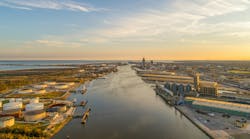A SiteSaver storm water treatment device was installed under the Route 242 parking lot at the Jay Peak Ski Resort in Jay, Vt., as part of the resort’s Water Quality Remediation Plan.
The Route 242 parking lot, located at the intersection of Stateside Road and Route 242, was constructed prior to the adoption of storm water treatment regulations. Storm water runoff from the site and adjacent developed areas has historically discharged to receiving waters without significant storm water treatment. After monitoring the receiving water—Tributary 3 of South Mountain Branch—officials determined that the stream was not meeting the state’s water quality standards due to high sediment loads.
In accordance with the Water Quality Remediation Plan, the resort was required to implement a “large-scale BMP” in 2018 and selected to retrofit a storm water treatment device under the parking lot with the objective of reducing the annual sediment loading to the stream. Andrew Mills, P.E., project manager for engineering firm VHB, said that surface solutions and infiltration practices were also evaluated for this project; however, space and natural resource constraints limited the area available for a surface solution, and infiltration was not practicable at this location due to the underlying soils classification (Cabot silt loam, hydrologic soil group “D”). Therefore, a subsurface, flow-through system was determined to be the optimal device for the retrofit project.
The Solution
SiteSaver, StormTrap’s hydrodynamic separator, was selected for this project for its ability to remove 80% total suspended solids (TSS) from runoff while also preserving the existing land use.
“The project constraints required a subsurface treatment system that had to be located within a limited footprint and with minimal head through the system,” Mills said. “The SiteSaver met these criteria while also providing an internal high-flow bypass and ease of maintenance.”
[Visit StormTrap's SWS Storefront]
The SiteSaver designed for this project was an STSS-4 unit composed of a precast concrete structure that housed inclined plates and baffles to remove suspended sediment, and a netting device to capture trash and floating debris. The device is predicted to achieve greater than 80% TSS removal based upon the anticipated particle distribution of the sediment and the design water quality flow rate of 3.1 cu ft per second (cfs). Because the system was placed online, an internal bypass was used to safely convey the 100-year flow rate of 25 cfs without causing previously captured sediment to become re-suspended or scoured. According to calculations for the site under existing conditions, the treatment system is anticipated to capture 20,080 lb of sediment annually that otherwise would have entered Tributary 3.
The Results
The system was installed in one day, and the engineer of record affirmed that it was a positive experience to work with StormTrap on this project. The StormTrap team “provided support throughout the project, from conceptual design and calculations to pricing as well as onsite installation support,” Mills said.







